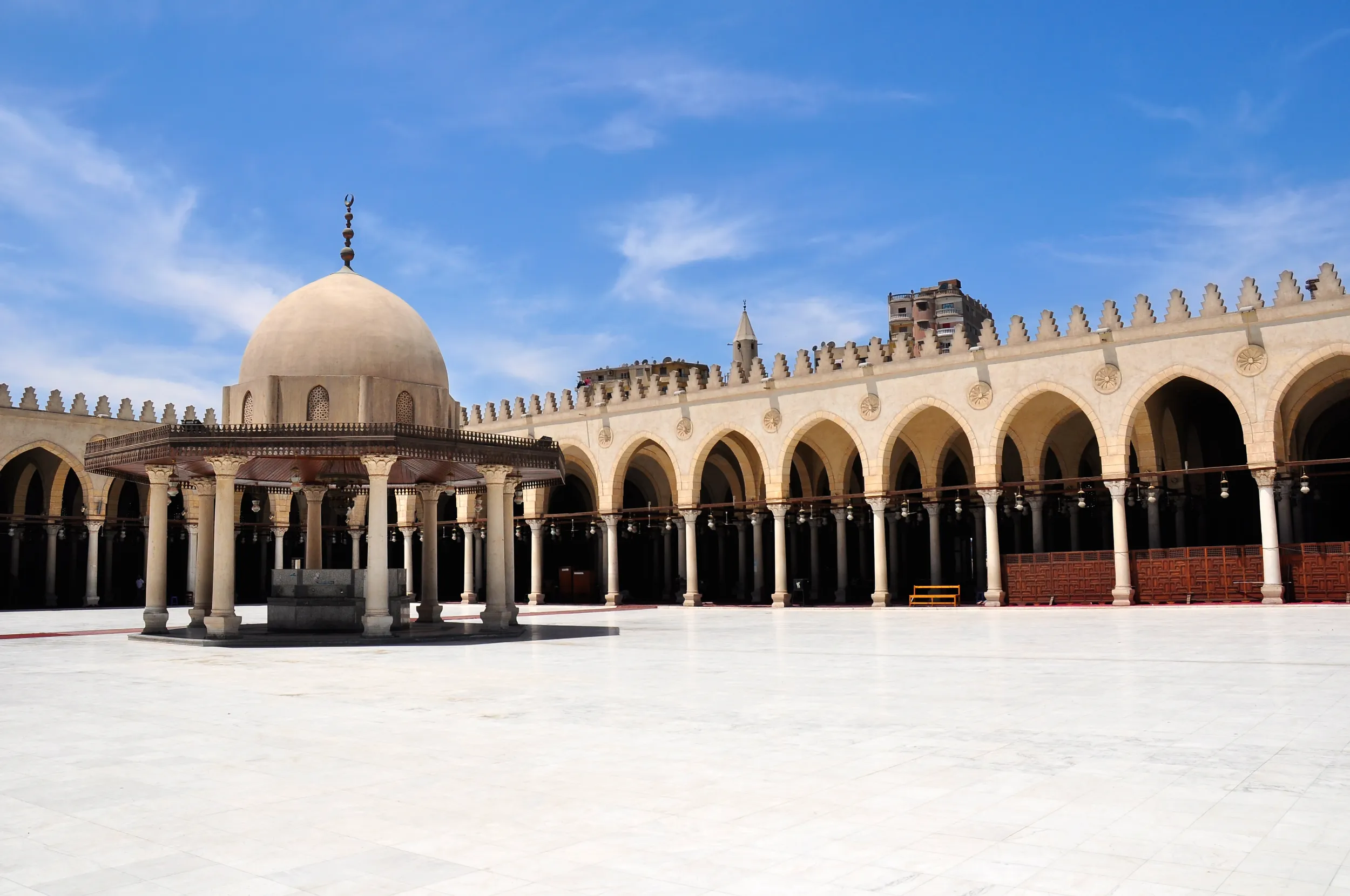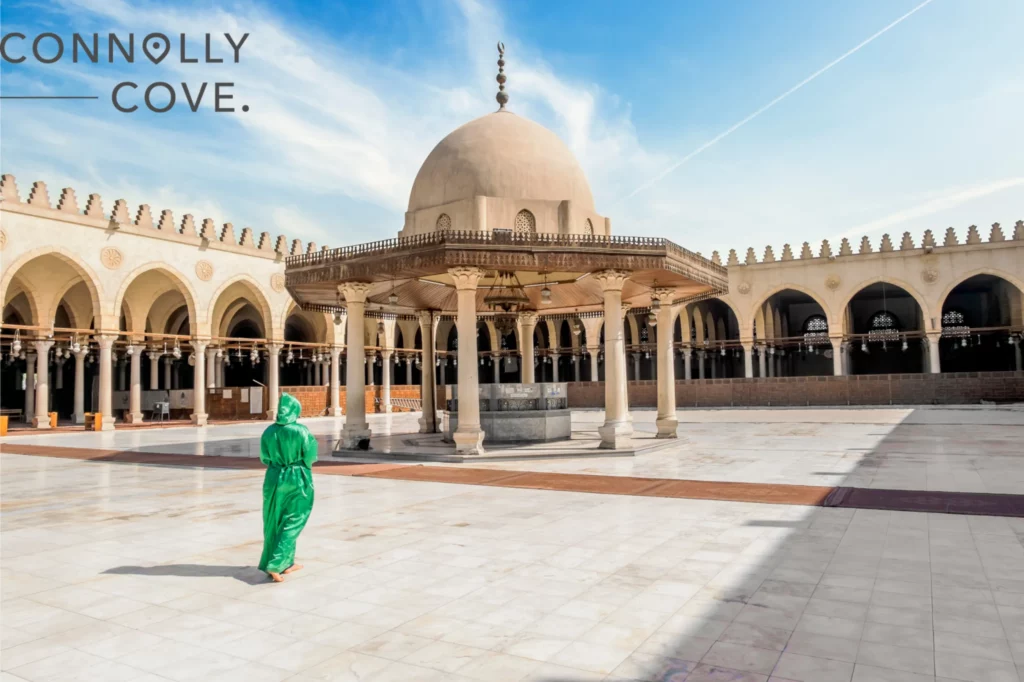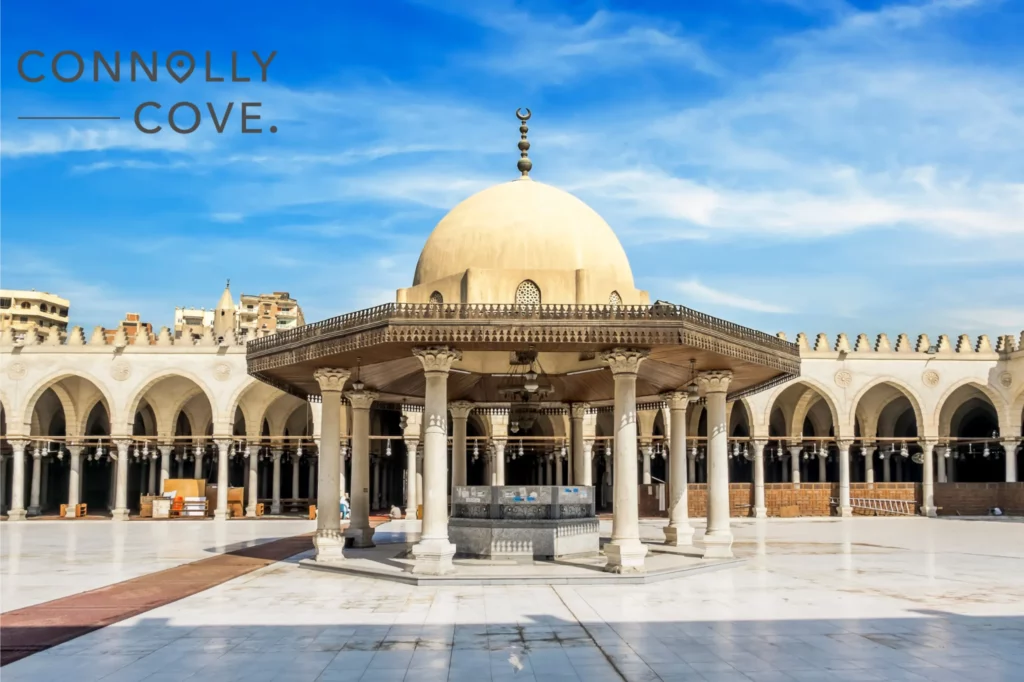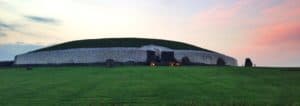Amr Ibn Al Aas: A Great Guide to Cairo’s First Mosque

Updated On: February 19, 2024 by Marwa Abdel Moniem
Walking down the streets of Old Cairo, suddenly, you hear the call for prayers coming from the oldest mosque in Egypt — Amr Ibn Al Aas, where Egyptian history and Islamic architecture meet. To start from the Mosque of Amr Ibn Al Aas, that’s logical thinking, and to know its story, that’s what this article will tell you.
The Mosque of Amr Ibn Al Aas was the place of worship that saw Cairo’s conversion to Islam and heralded the beginning of a great architectural history that brought about what is now referred to as Islamic Cairo.
So, if you ask us about the best place to explore Islamic Cairo, we will tell you to start with the Mosque of Amr Ibn Al Aas. Read on as we give you a closer look at the Arab commander after whom the mosque was named, the structure of the mosque and the important changes that were introduced to its original design over the years.
Table of Contents
Who Is Amr Ibn Al Aas?
Amr Ibn Al Aas was a prominent Arab commander, but his name is better associated with Egypt. Hailing from a wealthy Qurayshite tribe, Amr Ibn Al Aas was born in 573 AD in Mecca, now a province of the Kingdom of Saudi Arabia, and embraced Islam in 629 AD.
Amr Ibn Al Aas led the Muslim conquest of Egypt and founded the city of Fustat, where his mosque now stands, to the north of the Roman Port of Babylon. He was appointed by the Caliph as governor of Egypt between 640 AD and 646 AD, then in 658 AD until he died in 664 AD at the age of 91.
To install an Islamic state in Egypt, Amr Ibn Al Aas built a mosque, which was the first in Egypt and the whole of Africa. Muslims used to erect mosques in the areas they entered. It was their way of announcing the beginning of the Islamic period. The Mosque of Amr Ibn Al Aas was built in 642 AD; hence, Egypt has become an Islamic state.
About the Mosque & the City

The Mosque of Amr Ibn Al Aas was built in the city of Fustat, which was newly established in 641 AD to serve as the capital of Egypt instead of Alexandria. It remained the capital for almost 500 years.
The mosque stands on what is said to have been the site of Amr Ibn Al Aas’ tent on the northwest bank of the Nile River in Fustat, now known as Old Cairo.
An important note: built as a religious capital, Fustat later evolved into a cultural hub of Egypt with all its surviving mosques, churches and synagogues.
But the Mosque of Amr Ibn Al Aas was not only the first Muslim place of worship in Egypt. It was also the first university to provide religious and science sessions and continued to do so for about 600 years. The mosque also served as a seat for judges to resolve disputes among people.
The Design of the Mosque of Amr Ibn Al Aas
A simple 29mx17m rectangle was the original design of the Mosque of Amr Ibn Al Aas. You can imagine it would be something like that—it was built in the seventh century (642 AD)! Palm tree trunks and mud bricks were used to make the columns of the mosque, whose roof was mainly made of wood and palm leaves.
The floor was just gravel, and the mosque had two north doors and two others opposite the house of Amr Ibn Al Aas. A key note here—the original layout of the mosque was sans decorations and sans minarets!
The Mosque of Amr Ibn Al Aas over the Years

The Mosque of Amr Ibn Al Aas was first renovated in 673 AD. The walls and ceiling were decorated, and the floor was covered with straw mats. Also, four minarets were built at each of the mosque’s corners. No expansions were made to the mosque at this time.
The mosque was demolished and rebuilt over an expanded area in 698 AD. The rebuilt mosque had a wooden pulpit, four gold-coated columns and a niche. It also had 11 doors: four to the east, four to the west and three to the north.
In 827 AD, a new extension was made to the southwest side of the Mosque of Amr Ibn Al Aas, bringing the area to a total of 112mx120m, which remained unchanged until now. Seven new halls were built, each having an arcade of columns with wooden architraves on the last columns that were attached to the wall. Some of those old architraves are still found along the southern wall of the mosque.
Gilded mosaics and marble works were first seen inside the Mosque of Amr Ibn Al Aas during the Fatimid era. It was then that the idea of having a moving pulpit was introduced. Part of the mosque’s niche also got a coat of silver. We can say that the mosque restoration process reached a peak during the Fatimid era.
However, in 1668 AD, with a growing threat of the Crusaders invading Egypt, Fatimid ruler Vizier Shawar ordered the evacuation of Fustat and set the city ablaze. The fire was so massive that it continued for 54 days. He burnt the capital to prevent the Crusaders from entering it, and the Mosque of Amr Ibn Al Aas was severely damaged. In 1169, Saladin was named Vizier of Egypt. He became Sultan in 1171 AD and rebuilt the mosque in 1179 AD.
In 1796 AD, Mourad Bey, a Mamluk leader, made some changes to the interior of the Mosque of Amr Ibn Al Aas after some of the columns collapsed. The restructuring saw a decrease in the number of column arcades from seven to six and a change in their orientation to run perpendicular to the Qibla wall.
Mourad Bey is believed to have also built two minarets: one above the right entrance and the other above the right end of the Qibla wall. The two minarets still exist today. The ceiling was also renovated, the floor was covered with mats, and candelabras were positioned inside the mosque. Four foundation tablets were also placed and are still there.
In 1906, Khedive Abbas Helmy II of Egypt restored the entire mosque, and in the 1980s, parts of the entrance were rebuilt. A mausoleum is found at the southern corner of the Qibla Riwaq and below the dome of the mosque. Unconfirmed stories suggest that Abdullah, the son of Amr Ibn Al Aas, was buried there.
The Current Layout of the Mosque of Amr Ibn Al Aas
Having undergone many structural amendments since its construction in the seventh century, the Mosque of Amr Ibn Al Aas, in its current shape, is poles apart from the original layout.
Its design is still simple, with an open court (the sahn) surrounded by four hallways (the riwaqs). The Mosque of Amr Ibn Al Aas now features 150 white marble columns and three minarets. Byzantine carvings can be seen on some wooden plaques that decorate the mosque.
Until today, prayers are still being held at the Mosque of Amr Ibn Al Aas, which is considered one of the most attractive destinations in Islamic Cairo.
Islamic Cairo: A UNESCO World Heritage Site
In 1979, Historic Cairo was designated as a World Heritage site by the United Nations Educational, Scientific and Cultural Organization (UNESCO)—a status it rightly acquired as one of the oldest Islamic cities, given the number of ancient and famous mosques it houses.
Founded in the 10th century, Cairo is one of the oldest Muslim cities with numerous madrasas, hammams and fountains, all of which are prominent features of the Islamic places of worship.
Tourists are generally allowed to visit ancient mosques, such as that of Amr Ibn Al Aas. In fact, visits to the ancient mosques are organised by travel agencies as part of their Islamic Cairo programmes designed for tourists.
A Mosque Worth a Visit!
When you plan to explore Islamic Cairo, have the Mosque of Amr Ibn Al Aas as a starter. From there, the Islamic culture blossomed, and an Islamic state was announced. Now that you know the whole story of Cairo’s first mosque, you might think of a visit to Islamic Cairo in general and the Mosque of Amr Ibn Al Aas in particular.
Islamic Cairo has always had its charm, with a blend of history and architecture that defines the different periods of each site. What is unique about the Mosque of Amr Ibn Al Aas, though, is that it has undergone numerous changes that reflected every era since its construction in the 7th century. The Mosque of Amr Ibn Al Aas is undoubtedly worth a visit!






